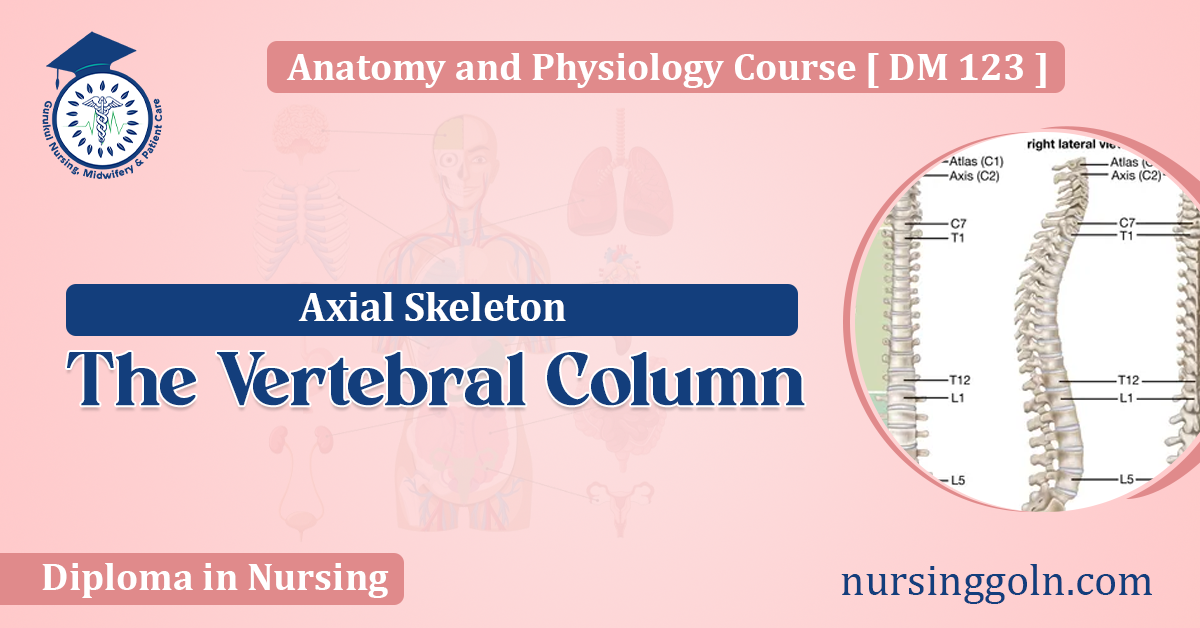The vertebral column, often referred to as the spine or backbone, is a vital structural component of the axial skeleton. Providing both support and flexibility, it plays an essential role in our everyday movements, from walking and lifting to bending and twisting. This article delves into the intricacies of the vertebral column, exploring its anatomy, function, and the role it plays within the human body.
The Vertebral Column : Axial Skeleton
Overview of the Axial Skeleton
Before examining the vertebral column in detail, it’s crucial to understand the broader context of its location. The human skeleton is typically categorized into two primary divisions: the axial and appendicular skeletons. The axial skeleton consists of 80 bones and includes the skull, vertebral column, and rib cage, providing protection for many of the body’s vital organs. The appendicular skeleton, comprising the remaining 126 bones, includes the limbs and girdles.
Anatomy of the Vertebral Column
The vertebral column consists of a series of bones called vertebrae, stacked on top of one another. These vertebrae are categorized into five regions:
- Cervical vertebrae (C1-C7): Located in the neck. The first cervical vertebra, known as the atlas, supports the skull and allows for the nodding motion of the head. The second, called the axis, permits the rotation of the head from side to side.
- Thoracic vertebrae (T1-T12): These vertebrae are located in the upper and middle back and correspond with the ribs’ attachment points.
- Lumbar vertebrae (L1-L5): Situated in the lower back, these are the largest and bear the majority of the body’s weight.
- Sacral vertebrae (S1-S5): These vertebrae are fused together in adults to form the sacrum, which fits between the two hip bones.
- Coccygeal vertebrae: Generally consisting of 3-4 bones, they are fused to form the coccyx or tailbone, which is the vertebral column’s terminal point.
Between each vertebra is an intervertebral disc made of fibrocartilage. These discs function as shock absorbers, cushioning the vertebrae from each other during movements and preventing bone-to-bone contact.
Ligaments and Muscles: The vertebral column is supported and stabilized by numerous ligaments and muscles. These tissues prevent excessive movement that might result in injury.
Vertebral Canal: Running through the vertebral column is a canal that houses and protects the spinal cord, a critical pathway for nerve impulses traveling between the body and the brain.
Function of the Vertebral Column
- Support: The vertebral column provides structural support, maintaining an upright posture and serving as an anchor for the body’s weight. It provides attachment points for muscles and ligaments.
- Protection: One of its primary roles is to safeguard the spinal cord, a crucial part of the central nervous system. This protection is essential for the preservation of motor and sensory functions.
- Flexibility and Movement: Due to its segmented nature and the presence of intervertebral discs, the spine is highly flexible. This allows for various movements, including flexion (bending forward), extension (bending backward), lateral bending (side-to-side motion), and rotation.
- Hemopoiesis: The vertebral column’s bones are rich in red bone marrow, responsible for blood cell production in adults.
Disorders of the Vertebral Column
The vertebral column, despite its robustness, is susceptible to various disorders:
- Scoliosis: A lateral curvature of the spine.
- Kyphosis: An excessive outward curvature of the spine, leading to a hunchback appearance.
- Lordosis: An exaggerated inward curvature of the lumbar spine, often referred to as “swayback.”
- Herniated Disc: Occurs when the soft inner part of an intervertebral disc protrudes through a crack in the tougher exterior casing.
- Osteoporosis: A condition where bones become weak and brittle. The vertebrae are especially prone to fractures due to osteoporosis.
- Spinal Stenosis: A narrowing of the spaces within your spine, which can put pressure on the nerves traveling through the spine.
The vertebral column is a masterpiece of structural engineering. As an essential component of the axial skeleton, it provides both strength and flexibility, serving as a protective conduit for the spinal cord while offering a framework for movement and support. Its intricate anatomy and multi-faceted functions showcase the complexity and efficiency of human biomechanics. Understanding the vertebral column, its anatomy, and its potential disorders is crucial for anyone interested in human physiology, movement sciences, or medical disciplines. Through such knowledge, we gain a deeper appreciation for the body’s design and the critical role the spine plays in daily life and overall health.
